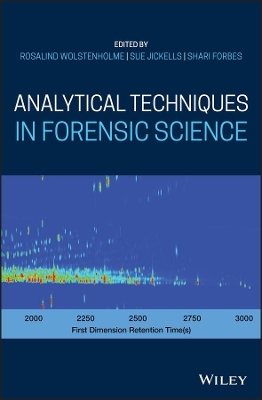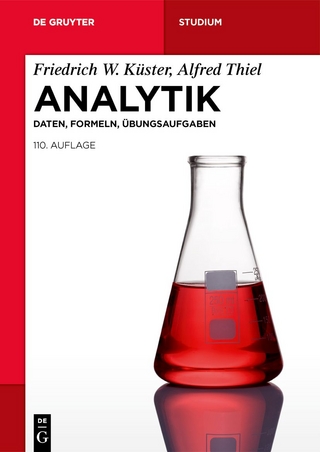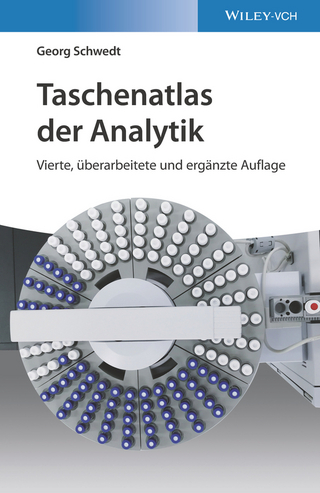
Analytical Techniques in Forensic Science
John Wiley & Sons Inc (Verlag)
978-1-119-97828-2 (ISBN)
Analytical Techniques in Forensic Science is a comprehensive guide written in accessible terms that examines the interface between analytical chemistry and trace evidence in forensic science. With contributions from noted experts on the topic, the text features a detailed introduction analysis in forensic science and then subsequent chapters explore the laboratory techniques grouped by shared operating principles. For each technique, the authors incorporate specific theory, application to forensic analytics, interpretation, forensic specific developments, and illustrative case studies.
Forensic techniques covered include UV-Vis and vibrational spectroscopy, mass spectrometry and gas and liquid chromatography. The applications reviewed include evidence types such as fibers, paint, drugs and explosives. The authors highlight data collection, subsequent analysis, what information has been obtained and what this means in the context of a case. The text shows how analytical chemistry and trace evidence can problem solve the nature of much of forensic analysis. This important text:
Puts the focus on trace evidence and analytical science
Contains case studies that illustrate theory in practice
Includes contributions from experts on the topics of instrumentation, theory, and case examples
Explores novel and future applications for analytical techniques
Written for undergraduate and graduate students in forensic chemistry and forensic practitioners and researchers, Analytical Techniques in Forensic Science offers a text that bridges the gap between introductory textbooks and professional level literature.
ROSALIND WOLSTENHOLME, BSC, MSC, PhD, is a senior lecturer in analytical science in the Department of Biosciences and Chemistry, Sheffield Hallam University, UK. SUE JICKELLS, BSC, MSC, PhD, is a retired analytical chemist, formerly at the University of East Anglia and King's College London. SHARI FORBES, BSC, PhD, is a forensic scientist and researcher with the Department of Chemistry, Biochemistry and Physics, University of Quebec Trois-Rivières, Canada.
List of Contributors xvii
Preface xix
Acknowledgements xxi
Part I Preparing for Analysis 1
1 Introduction to Forensic Science 3
Sue Jickells, Rosalind Wolstenholme and Shari Forbes
1.1 Forensic Science 3
1.2 The Forensic Process 6
1.2.1 Forensic Principles and the Crime Scene 6
1.2.2 Preparatory Issues in Laboratory Analysis 11
1.2.3 Interpretation of Forensic Evidence 13
1.2.3.1 The Expert Witness and Interpretation 14
1.2.3.2 Evidential Value 15
1.2.3.3 Statistical Interpretation 18
1.2.3.4 Bayesian Statistics 20
1.3 Judicial Systems 22
1.3.1 Criminal vs. Civil Law 22
1.3.2 Adversarial vs. Inquisitorial System 24
1.3.3 Rules of Evidence 25
1.3.3.1 Admissibility of Evidence 25
1.3.4 Types of Evidence 26
1.3.5 Opinion and Expert Testimony 28
1.3.5.1 Admissibility of Scientific and Technical Evidence 28
1.4 The Role of Analytical Chemistry in Forensic Science 30
1.4.1 Techniques Used for Chemical Analysis 31
References 32
2 Analytical Methodology and Experimental Design 35
Florian Wulfert and Rosalind Wolstenholme
2.1 Scientific Method 35
2.2 What DoWe Mean by Analysis? 36
2.3 The Stages of Analysis 36
2.3.1 Quantification 37
2.3.1.1 External Standards 37
2.3.1.2 Internal Standards 38
2.3.1.3 Standard Addition 38
2.4 Analysis Development 39
2.4.1 Error Estimation 39
2.4.2 Quality Assurance and Quality Control 40
2.4.3 Method Development and Experimental Designs 41
2.4.4 Selecting Critical Variables with Factorial Designs 42
2.4.4.1 Categorical Variables 43
2.4.4.2 Reduced Designs 44
2.4.4.3 Final Practical Experimental Considerations 44
2.4.4.4 Deciding on Significance 44
2.4.4.5 Interpretation 45
2.4.5 Modelling the Significant Variables Using Response Surface Designs 46
2.4.5.1 Sparse Response Surface Designs 48
2.4.5.2 Analysing Response Surface Models 48
2.4.5.3 Validation 49
2.4.5.4 Optimisation 49
3 Presumptive Testing 51
Rosalind Wolstenholme and Shari Forbes
3.1 Introduction 51
3.2 Drugs 52
3.2.1 Drugs Seizure Sampling 52
3.2.2 Major Drug Classes 52
3.2.2.1 Marijuana 52
3.2.2.2 Opioids, Cocaine, and Amphetamines 53
3.2.2.3 Barbiturates and Benzodiazepines 53
3.2.2.4 LSD 53
3.2.2.5 New Psychoactive Substances 55
3.2.3 Presumptive Tests for Drugs 56
3.2.3.1 Colour Tests 56
3.2.3.2 Thin Layer Chromatography 56
3.2.3.3 Microcrystal Tests 56
3.3 Firearms Discharge Residue 57
3.3.1 Firearms Discharge Residue Sampling 57
3.3.2 Firearms Discharge Residue Presumptive Tests 58
3.4 Explosives 59
3.4.1 Explosive Residue Sampling 60
3.4.2 Explosive Residue Presumptive Tests 60
3.4.2.1 Colour Tests 60
3.4.2.2 Thin Layer Chromatography 61
3.4.2.3 Portable Instruments 61
3.5 Ethanol (Ethyl Alcohol) 61
3.5.1 Breath Alcohol Testing 61
3.5.1.1 Electronic Devices 62
3.5.1.2 Chemical Test Devices 63
3.5.2 Saliva-Based Testing 63
3.6 Ignitable Liquid Residues 64
3.7 Non-Chemical Presumptive Tests 65
3.7.1 Electronic Detectors 65
3.7.1.1 Electronic Detectors for Fire Investigations 65
3.7.1.2 Electronic Detectors for Explosives and Illicit Drugs 66
3.7.2 Canine Detection 67
References 68
4 Sample Preparation 71
Sue Jickells
4.1 Sample Preparation 71
4.2 Extraction 75
4.2.1 Solvent Extraction 76
4.2.2 Liquid–Liquid Extraction 77
4.2.3 Solid Phase Extraction 82
4.2.3.1 Stationary Phases 85
4.2.3.2 Normal Phase 92
4.2.3.3 Reversed Phase 93
4.2.3.4 Ion Exchange 95
4.2.3.5 Molecularly Imprinted Polymers 95
4.2.3.6 Immunoaffinity SPE 97
4.2.4 Solid-Phase Microextraction 97
4.2.5 QuEChERS 101
4.2.6 Sample Handling Post Extraction 101
4.2.6.1 Solvent Evaporation 101
4.2.6.2 Derivatisation 102
4.3 Sample Preparation for Inorganic Analyses 102
4.3.1 Total Analysis 103
4.3.2 Chemical Speciation 105
4.4 DNA Profiling 105
4.5 Conclusion 106
References 106
Part II Spectroscopic and Spectrometric Techniques 109
5 The Electromagnetic Spectrum 111
Rosalind Wolstenholme
Reference 114
6 Ultraviolet–Visible and Fluorescence Spectroscopy 115
Rosalind Wolstenholme
6.1 Forensic Introduction 115
6.2 Theory 115
6.2.1 Electronic Transitions 115
6.2.2 Photoluminescence and Fluorescence 118
6.2.3 Quantification 120
6.2.3.1 UV-Vis Quantification 120
6.2.3.2 Fluorescence Quantification 121
6.3 Instrumentation 122
6.3.1 UV-Vis Spectrometers 122
6.3.2 Fluorescence Spectrometers/Fluorometers 123
6.3.3 Coupling Techniques 126
6.3.4 Microspectrophotometers 126
6.3.5 Hyperspectral Imaging 126
6.3.6 Filtered Light Examination 127
6.4 Application to Analyte 128
6.4.1 Transmission Analysis in Solution 128
6.4.1.1 UV-Vis Solution Analysis 128
6.4.1.2 Fluorescent Solution Analysis 129
6.4.2 MSP Sample Preparation 129
6.4.3 Acquiring a Spectrum 130
6.4.3.1 Capture of Spectra in Solution 130
6.4.3.2 MSP and HSI Sample Analysis 131
6.4.4 Forensic Applications 131
6.4.4.1 Writing Ink Examination 132
6.4.4.2 Fibre Examination 133
6.5 Interpretation and Law 134
6.5.1 Interpreting UV-Vis Spectra 135
6.5.2 Interpreting Fluorescence Spectra 137
6.5.3 UV-Vis and Fluorescence Spectroscopy in Court 138
6.6 Case Studies 138
6.6.1 Case Study 1 138
6.6.2 Case Study 2 139
6.7 Forensic Developments 140
References 140
7 Infrared Spectroscopy 145
Barbara Stuart
7.1 Introduction 145
7.2 Theory of the Technique 145
7.2.1 Basis of the Technique 145
7.2.2 Instrumentation 146
7.2.3 Transmission Spectroscopy 148
7.2.4 Reflectance Spectroscopy 148
7.2.5 Infrared Microspectroscopy 150
7.2.6 Handheld and Portable Instruments 151
7.3 Application to Analyte 151
7.3.1 Sampling 151
7.3.2 Spectrum Analysis 152
7.4 Interpretation and Law 155
7.5 Case Studies – Discrimination of Acrylic Fibres 157
7.6 Forensic Developments 158
References 159
8 Raman Spectroscopy 161
Rosalind Wolstenholme
8.1 Forensic Introduction 161
8.2 Theory 161
8.2.1 Raman Scattering 161
8.2.2 Modes of Vibration 163
8.2.3 Raman Shift 165
8.2.4 Raman Instrumentation 166
8.2.4.1 Lasers, Fluorescence, and Resolution 166
8.2.4.2 Dispersive versus FT 167
8.2.4.3 Dispersive Raman Spectrometers 168
8.2.4.4 FT-Raman Spectrometers 169
8.2.4.5 Polarisers 169
8.2.4.6 Microscopes and Imaging 169
8.2.4.7 Portable Instruments and Probes 170
8.2.4.8 Quantitation 170
8.2.5 Advanced Techniques 171
8.2.5.1 Resonance Raman Spectroscopy 171
8.2.5.2 SERS/SERRS 171
8.2.5.3 SORS 172
8.2.6 Advantages and Disadvantages of Raman Spectroscopy 173
8.3 Application to Analyte 174
8.3.1 Acquiring a Spectrum 174
8.3.2 Forensic Applications 175
8.3.2.1 Pen Ink 175
8.3.2.2 Paint 175
8.3.2.3 Drugs of Abuse 176
8.4 Interpretation and Law 177
8.4.1 Interpreting Raman Spectra 177
8.4.2 Raman Spectroscopy in Court 179
8.5 Case Studies 180
8.5.1 Case Study 1 180
8.5.2 Case Study 2 180
8.6 Forensic Developments 181
References 181
9 Scanning Electron Microscopy 185
Grzegorz Zadora and Aleksandra Michalska
9.1 Introduction 185
9.2 Theory of the Technique 186
9.2.1 Scanning Electron Microscope 186
9.2.2 X-Ray Detection 191
9.2.3 Operating Conditions 192
9.2.4 Specimen Preparation 193
9.2.4.1 Vacuum Evaporation 194
9.3 Application to Analyte(s) 195
9.3.1 Gunshot Residue 196
9.3.2 Glass 200
9.3.3 Other Samples 203
9.4 Interpretation and Law 203
9.4.1 Evidence Evaluation on Source Level 203
9.4.2 Evidence Evaluation on Activity Level 206
9.5 Case Study 207
9.5.1 GSR – Case Study 207
9.5.2 Glass – Comparison and Classification Problem 209
9.5.3 Glass –Was the Car Bulb Switched on During the Accident? 212
References 214
10 Mass Spectrometry 219
Mark C. Parkin and Alan Brailsford
10.1 Introduction 219
10.1.1 Forensic Application of Mass Spectrometry 221
10.2 Theory of the Technique 223
10.2.1 Principles of Mass Spectrometry 223
10.2.2 Sample Introduction 224
10.2.3 Modes of Sample Ionisation 225
10.2.3.1 Electron Ionisation 225
10.2.3.2 Chemical Ionisation 227
10.2.3.3 Electrospray Ionisation 230
10.2.3.4 Atmospheric Pressure Chemical Ionisation 231
10.2.3.5 Desorption and Ambient Methods 232
10.2.3.6 Matrix-Assisted Laser Desorption/Ionisation 232
10.2.3.7 Secondary Ion Mass Spectrometry 234
10.2.3.8 Desorption Electrospray Ionisation 234
10.2.3.9 Direct Analysis in Real Time 234
10.2.4 Ion Separation – Mass Analysers 235
10.2.4.1 Mass Range, Resolution and Accuracy 235
10.2.4.2 Magnetic Sector 236
10.2.4.3 Quadrupoles – Quadrupole Mass Filter 236
10.2.4.4 Quadrupole Ion Trap 237
10.2.4.5 Time of Flight 238
10.2.4.6 Fourier Transform Instruments – Ion Cyclotron Resonance 239
10.2.4.7 Fourier Transform Instruments – Orbitrap 240
10.2.4.8 Tandem Mass Spectrometry – Ion Fragmentation by Collision Induced Dissociation 241
10.2.4.9 Tandem Mass Analysers – Ion Traps 242
10.2.4.10 Tandem Mass Analysers – Triple Quadrupoles 242
10.2.4.11 Tandem Mass Analysers – Hybrid Instruments 242
10.2.5 Ion Detection 243
10.2.5.1 Electron Multipliers 243
10.2.5.2 Faraday Cup 244
10.2.6 Anatomy of a Mass Spectrum 244
10.2.6.1 The Molecular or Quasi-Molecular Ion 245
10.2.6.2 The Fragment Region 247
10.2.6.3 Full Scan Mass Spectra 247
10.2.6.4 Product Ion Spectra 248
10.2.6.5 Extracted Ion Chromatograms 248
10.2.6.6 Selected Ion Chromatograms and Multiple Reaction Monitoring 249
10.2.6.7 Precursor Ion Detection and Neutral Loss Scanning 252
10.3 Application to Analytes 252
10.4 Interpretation and Law 254
10.4.1 Chain of Custody 254
10.4.2 New Forensic Regulations 255
10.4.3 ID Criteria – Screen and Confirmation 255
10.4.4 Chromatographic Criteria 256
10.4.5 Mass Spectrometric Identification Criteria 256
10.5 Case Studies 257
10.5.1 Serial Killing by Poisoning 257
10.5.2 Surreptitious Insulin Administration 257
10.6 Forensic Developments 258
10.6.1 Beyond Blood and Urine 258
10.6.2 High Mass Accuracy Mass Spectrometry 259
10.6.3 Mobile Mass Spectrometers 260
References 261
11 Isotope Ratio Mass Spectrometry 267
Sarah Benson and Kylie Jones
11.1 Forensic Introduction 267
11.2 Basis of the Technique 268
11.2.1 Isotopes 268
11.2.2 Isotopic Abundance and Delta Notation 268
11.2.3 Standards and Reference Materials 269
11.2.4 Isotopic Variability – Fractionation and Mixing 270
11.2.5 Isotopic Variability of Natural Materials 272
11.2.6 Instrumentation: Stable Isotope Ratio Mass Spectrometers 272
11.3 Introduction to the Isotope Ratio Mass Spectrometer 276
11.3.1 IRMS – Detection and Measurement 276
11.3.2 Sample Preparation 277
11.3.3 Bulk Stable Isotope Analysis 277
11.3.4 Bulk Measurements by Quantitative High Temperature Combustion 278
11.3.5 Bulk Measurements by Quantitative High Temperature Conversion 279
11.3.6 Compound Specific Isotope Analysis 279
11.4 Interpretation 280
11.5 Case Studies 281
11.6 Applications in Forensic Science 283
11.6.1 Distinguishing between Naturally Occurring and Synthetic Materials in Doping, e.g. Endogenous and Exogenous (Synthetic) Testosterone 284
11.6.2 Determining Authenticity and Predicting Geographical Origin of Food, Pharmaceuticals and Other Materials, e.g. Counterfeiting 284
11.6.3 Tracing the Geographic Origin and Movement of Wildlife, Persons and Materials 284
11.6.4 Identifying the Source of Environmental Contaminants 285
11.6.5 Determining the Geographical Origin of Plant Materials, e.g. Natural Illicit Drugs – Cannabis, Cocaine, and Heroin 285
11.6.6 Characterising Microorganisms 286
11.6.7 Determining Synthetic Pathways Used to Manufacture Illicit Drugs, e.g. Ecstasy and MDMA, Methamphetamine, and Amphetamine 286
11.6.8 Distinguishing between Two or More Samples of a Material to Infer Source or a Common Origin 287
11.6.9 Distinguishing Between Two or More Samples of Ignitable Liquids and Chemicals 287
11.6.10 Determining Source Through Association of Starting Materials and End Products, e.g. Explosives 288
11.7 Future of IRMS and Stable Isotopic Comparisons 288
References 288
Part III Chromatographic Techniques 295
12 Chromatographic Separation and Theory 297
Sue Jickells and Shari Forbes
12.1 Introduction 297
12.2 Chromatography 298
12.2.1 Planar Chromatography 299
12.2.2 Column Chromatography 300
12.3 The Separation Process 300
12.3.1 Distribution Constant 303
12.3.2 Hold-Up Time (or Volume) 304
12.3.3 Retention Time (or Volume) 305
12.3.3.1 Retention Time and Sample Concentration 306
12.3.4 Retention Factor 306
12.3.5 Separation Factor 307
12.4 Separation Theory 307
12.4.1 Plate Theory 307
12.4.2 Theory versus Practice: Band Broadening 308
12.4.3 Rate Theory 311
12.4.3.1 Eddy Diffusion (A) 312
12.4.3.2 Longitudinal Diffusion (B) 313
12.4.3.3 Mass Transfer (C) 314
12.4.3.4 Non-Column Parameters Contributing to Band Broadening 316
12.5 Practical Applications of Chromatographic Theory 316
12.5.1 Optimising Chromatographic Separations 317
12.5.1.1 Resolution 317
12.5.1.2 GC 319
12.5.1.3 Mobile Phase 320
12.6 Conclusion 323
References 323
13 Gas Chromatography 327
Shari Forbes
13.1 Introduction 327
13.2 Gas Chromatography Components 327
13.2.1 Mobile Phase System 328
13.2.2 Sample Injection System 329
13.2.2.1 Liquid Samples 330
13.2.2.2 Gases and Volatile Compounds 334
13.2.2.3 Gas Samples 334
13.2.2.4 Volatile Compounds: Headspace Analysis 335
13.2.2.5 Static Headspace Analysis 335
13.2.2.6 Dynamic Headspace Analysis 336
13.2.2.7 Pyrolysis GC 338
13.2.3 Columns and Chromatographic Separation 338
13.2.3.1 Column Selection 340
13.2.3.2 Column Temperature and Programming 341
13.2.4 Detectors and Detection Systems 343
13.2.4.1 Flame Ionisation Detectors 344
13.2.4.2 Electron Capture Detectors 345
13.2.4.3 Nitrogen–Phosphorous Detectors 345
13.2.4.4 Mass Spectrometric Detection Systems 346
13.3 Application to Analyte 348
13.3.1 Sample Derivatisation 348
13.3.2 Qualitative Analysis 350
13.3.3 Quantitative Analysis 351
13.3.3.1 Methods of Quantitative Analysis 353
13.4 Interpretation and Law 354
13.5 Case Studies 356
13.5.1 Case Study 1 356
13.5.2 Case Study 2 357
13.6 Forensic Developments 358
13.6.1 Multidimensional GC 358
13.6.2 Portable GC 361
References 362
14 High Performance Liquid Chromatography and Ultra-High Performance Liquid Chromatography Including Liquid Chromatography–Mass Spectrometry 365
Sophie Turfus and Luke N. Rodda
14.1 Introduction 365
14.2 Components of an HPLC instrument and their Optimisation 368
14.2.1 Pump and Mixer 368
14.2.2 Autosampler and Inlet 370
14.2.3 Injector 370
14.2.4 Column 370
14.2.4.1 Stationary Phase 371
14.2.4.2 Column Dimensions 373
14.2.4.3 Particle Size 373
14.2.4.4 Pre-Column/Guard Column 373
14.2.5 Fittings 374
14.2.6 Mobile Phase 375
14.2.6.1 Mobile Phase A 376
14.2.6.2 Mobile Phase B 376
14.2.7 Effect of Temperature/Flow Rate 379
14.2.8 Detector 380
14.2.8.1 Mass Spectrometer 380
14.2.8.2 UV Detector 382
14.2.8.3 PDA Detector 383
14.3 Related Techniques 384
14.3.1 Ion Chromatography 384
14.3.2 Affinity Chromatography 384
14.3.3 Chiral Chromatography 385
14.4 Chromatography Theory 385
14.5 Detection 386
14.6 Coupling of Liquid Chromatography to Mass Spectrometry 388
14.7 Types of Analytes 390
14.7.1 Basic Analytes 390
14.7.2 Acidic Analytes 390
14.7.3 Proteins 391
14.7.4 DNA 391
14.7.5 Chiral Compounds 392
14.7.6 Bulk Drugs and High-Concentration Analytes 392
14.7.7 Low-Concentration Analytes 392
14.8 Accreditation and Method Validation 393
14.8.1 Use of Internal Standards 393
14.8.2 Effect of Sample Matrix 394
14.8.3 Ion Ratios 394
14.9 Interpretation of Results in the Forensic and Legal Context 394
14.10 Case Studies 396
14.10.1 Case Study 1: Post-Mortem Death Investigation – Poly-Drug Overdose 396
14.10.2 Case Study 2: Post-Mortem Death Investigation – No Derivatisation Needed for LC-MS 397
14.10.3 Case Study 3: Driving Under the Influence of Drugs – Increased Sensitivity with LC-MS 398
14.11 Forensic Developments 399
14.11.1 Column Switching and Two-Dimensional HPLC 399
14.11.2 Capillary Liquid Chromatography 401
14.11.3 Column-on-a-Chip Technologies 401
14.12 Conclusion 402
References 402
15 Capillary and Microchip Electrophoresis 407
Lucas Blanes, Ellen Flávia Moreira Gabriel, Renata Mayumi Saito, Wendell Karlos Tomazelli Coltro, Nerida Cole, Philip Doble, Claude Roux and Robson Oliveira dos Santos
15.1 Capillary Electrophoresis: Introduction 407
15.2 Microchip-Capillary Electrophoresis 410
15.2.1 Sample Injection Modes in ME 410
15.3 Detection Systems 411
15.4 CE and ME in Forensic Analysis 412
15.5 Case Study: Lab-on-a-Chip Screening of Methamphetamine and Pseudoephedrine in Clandestine Laboratory Samples 412
15.5.1 Screening of Methamphetamine and Pseudoephedrine from Clandestine Laboratories 416
15.5.2 Interferents 416
15.5.3 Simulated Surface Swabs 418
15.6 Conclusions 418
Acknowledgements 419
References 419
Index 425
| Erscheinungsdatum | 29.01.2021 |
|---|---|
| Verlagsort | New York |
| Sprache | englisch |
| Maße | 175 x 244 mm |
| Gewicht | 1043 g |
| Themenwelt | Naturwissenschaften ► Biologie |
| Naturwissenschaften ► Chemie ► Analytische Chemie | |
| ISBN-10 | 1-119-97828-9 / 1119978289 |
| ISBN-13 | 978-1-119-97828-2 / 9781119978282 |
| Zustand | Neuware |
| Informationen gemäß Produktsicherheitsverordnung (GPSR) | |
| Haben Sie eine Frage zum Produkt? |
aus dem Bereich


